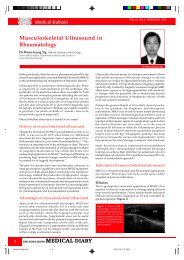MEDICAL DIARY - The Federation of Medical Societies of Hong Kong
MEDICAL DIARY - The Federation of Medical Societies of Hong Kong
MEDICAL DIARY - The Federation of Medical Societies of Hong Kong
You also want an ePaper? Increase the reach of your titles
YUMPU automatically turns print PDFs into web optimized ePapers that Google loves.
VOL.11 VOL.12NO.5 NO.7 MAY JULY 20062007<br />
Flaps can be further classified according to their type <strong>of</strong><br />
blood supply. 'Random flaps' receive their blood supply<br />
through a random array <strong>of</strong> blood vessels at their<br />
attached base, rather than through a defined blood<br />
supply. 'Pedicle flaps' remain attached through their<br />
pedicle <strong>of</strong> vessels that continue to provide their normal<br />
blood supply. 'Free flaps' have their normal blood<br />
supply disconnected from the native territory, moved in<br />
a new region, and then re-established blood supply in<br />
the new location by microscopic surgery.<br />
Free flap has an established role for reconstruction <strong>of</strong><br />
the head and neck defect in the recent decades. It<br />
enables selection <strong>of</strong> the most appropriate type <strong>of</strong> tissue<br />
in the appropriate amounts to precisely reconstruct the<br />
acquired defects. Moreover both resection <strong>of</strong> tumour<br />
and harvesting <strong>of</strong> the free tissue can usually be<br />
performed simultaneously, thus reducing the operating<br />
time and duration <strong>of</strong> general anaesthesia. Besides using<br />
microsurgical reconstruction, the resection <strong>of</strong> tumour<br />
can <strong>of</strong>ten be even more aggressive since repair <strong>of</strong> even<br />
large defects is possible. Finally, many patients with<br />
head and neck cancer require radiation treatment or<br />
chemotherapy, thus augmenting the need for a well<br />
vascularised tissue reconstruction. 7<br />
Decision on the use <strong>of</strong> reconstructive<br />
methods<br />
Reconstruction should be individualised to each<br />
patient. <strong>The</strong> decision to choose the correct type <strong>of</strong><br />
reconstruction will depends on:<br />
1. Patient's factors: the health status, age, donor sites<br />
conditions, willingness etc.<br />
2. Defect's factors: conditions <strong>of</strong> the defect, previous<br />
radiation, contaminations etc.<br />
3. Surgeon's factors: training and experience<br />
By and large, the simple methods are most economical<br />
and have higher success rate. <strong>The</strong> more complex<br />
methods are more costly and risky, but the outcomes<br />
are better. Some reconstruction methods involve<br />
multiple-staged operations while some are one staged.<br />
Some important questions related to choice <strong>of</strong><br />
reconstruction are listed in Table 2.<br />
Characteristics <strong>of</strong> head and neck<br />
cancer patients<br />
According to the <strong>Hong</strong> <strong>Kong</strong> Cancer Registry <strong>of</strong> 2003,<br />
the head and neck cancers represent the tenth most<br />
prevalent cancer in <strong>Hong</strong> <strong>Kong</strong>. Unfortunately,<br />
patients <strong>of</strong>ten present with advanced disease that<br />
requires aggressive treatment for cure. In addition,<br />
many <strong>of</strong> them are elderly, chronic smokers and/or<br />
drinkers, with compromised nutritional status. <strong>The</strong><br />
tumours <strong>of</strong>ten involve the aerodigestive tract affecting<br />
the airway, swallowing and speech functions. Some<br />
have history <strong>of</strong> radiotherapy with its associated<br />
complications. 8<br />
Surgical treatment <strong>of</strong> head and neck cancers, in certain<br />
cases, inflicts large and contaminated tissue defects.<br />
<strong>Medical</strong> Bulletin<br />
Some <strong>of</strong> these defects are associated with devastating<br />
functional deficits and disfiguring deformities. In<br />
addition, radiation therapy, whenever necessary, <strong>of</strong>ten<br />
leads to wound breakdown, dehiscence and fistula<br />
formation due to impaired healing mechanism. 7, 9-11<br />
Following extirpation <strong>of</strong> tumour in the head and neck<br />
region, there are essentially four types <strong>of</strong> defect needed<br />
to repair.<br />
1.<br />
2.<br />
3.<br />
4.<br />
Following resection <strong>of</strong> intraoral tumour or<br />
dermatological pathology, the subsequent mucosal<br />
or cutaneous defect requires coverage.<br />
When segmental mandibulectomy is performed for<br />
tumour arising from the lower alveolus, the bony<br />
defect and the intraoral mucosal deficiency need to<br />
be reconstructed simultaneously.<br />
After circumferential pharyngectomy, the gap<br />
between the oropharynx and oesophagus must be<br />
filled to reconstitute the continuity <strong>of</strong> the alimentary<br />
tract.<br />
Finally, after removal <strong>of</strong> a bulky tumour, the tissue<br />
defect, with, or without the overlying skin, has to be<br />
reconstructed to achieve a functional or aesthetic<br />
outcome.<br />
Ideally, reconstruction should aim at single stage<br />
replacement <strong>of</strong> lost tissue in volume and form,<br />
preferably with similar tissues, which are wellvascularised<br />
to combat the contaminations and achieve<br />
early complete healing and restoration <strong>of</strong> any lost<br />
functions. Nowadays free tissue transfer suits all <strong>of</strong><br />
these purposes and is safe and reliable in experienced<br />
hand.<br />
Accordingly the free flap used for the first type <strong>of</strong> defect<br />
includes the radial forearm flap, ulnar forearm flap,<br />
lateral arm flap and groin flap. Patches <strong>of</strong> colonic<br />
mucosa or gastric mucosa have also been used for<br />
reconstruction <strong>of</strong> intraoral mucosal defects. For the<br />
reconstruction <strong>of</strong> mandibular defects, the fibula and<br />
overlying skin island constituting an osteocutaneous<br />
flap are frequently used. In the early years, the radial<br />
forearm flap carrying with it a narrow block <strong>of</strong> radius<br />
bone has been used. To repair circumferential<br />
pharyngeal defects, free jejunal grafts are most<br />
frequently employed and occasionally, a tubed radial<br />
forearm flap is used. Free rectus abdominis muscle or<br />
myocutaneous flap and free latissimus dorsi<br />
myocutaneous flap have been employed to fill bulky<br />
defects. <strong>The</strong> latter has also been used to cover a large<br />
cutaneous defect. 7, 9<br />
Conclusion<br />
In conclusion, there are various methods available for<br />
head and neck reconstruction depending on the<br />
condition <strong>of</strong> the patient and complexity <strong>of</strong> the defect.<br />
Irrespective to the choice, the primary aim <strong>of</strong> the<br />
procedure should give a satisfactory result in terms <strong>of</strong><br />
both the functional and aesthetic outcomes. Today such<br />
goal can be accompanied for the most part with the free<br />
tissue transfer.<br />
15
















